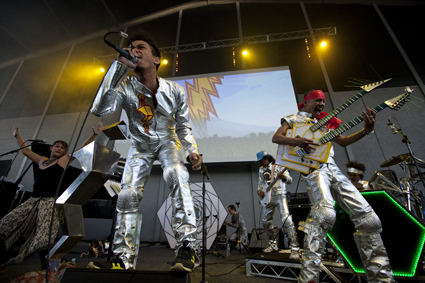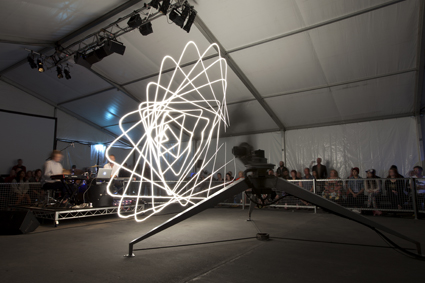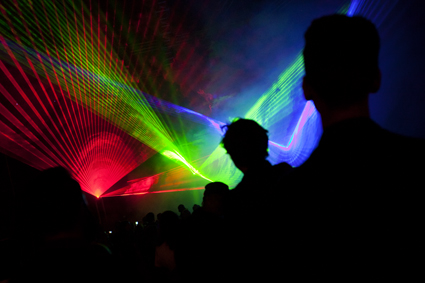Hectic, eclectic, enthralling
Gail Priest: MONA FOMA 2014, Hobart

Slave Pianos/Punkasila
photo Rémi Chauvin, courtesy MONA Museum of Old and New Art
Slave Pianos/Punkasila
On the opening night of MOFO concerts at the MAC Precinct, young families, middle-aged couples and 20-something hipsters (never seen so many beards) lounge on pink bean bags gently nodding to the mannered drawl of Mick Harvey doing Serge Gainsborough covers.
Then we all troop to the Back Space to see Melbourne’s conceptual art group Slave Pianos collaborating with Indonesian art band Punkasila. Following this, Sun Ra Arkestra is wheeled out of cryogenesis to recall what free jazz used to sound like and the night is topped off with Astronautilus, a Florida rapper who’s on a career high because he didn’t expect a crowd this big and the view from the top of Mt Wellington blew his “freakin’ mind!”
Eclectic seems barely adequate to describe Brian Ritchie’s curatorial approach. While we’re told this happens overseas all the time, it really is unique for Australia, and I suspect it particularly works because it’s in Hobart. Present this combination of acts in a city that’s comparatively spoiled for choice and audiences might just be a bit too picky, waiting for the sideshow to see only the act they know and already love.
Schizosonics
It’s not just that the overall combination of acts is eclectic, some of the performances are seriously varied within themselves. Take the Slave Pianos/Punkasila collaboration. It opens with Australia’s most renowned pianist Michael Kieran Harvey performing a virtuosic haute-classical solo for around 10 minutes. Punkasila, in silver suits, stand around waiting, offering an occasional guitar buzz or a drum skiffle. Harvey finishes and they launch into 20 minutes of playful punk rock over which Indonesian singer Rachel Saraswati ululates. Projected above is an animation of the comic The Lepidopters in which it seems moth creatures from outer space come to earth and somehow everyone gets all sexy. While the Kieran Harvey solo sits oddly at the beginning, the symbolic weight of the Western canon and its imperialistic overtones is powerful. Somehow, by the end, it all seems to make its own kind of sense.
Similarly, mandolin player Chris Thile presented an almost bi-polar set of classical hits for the mandolin (played with astounding virtuosity but alarming facial expressions) mixed with hillbilly folk and a Fiona Apple cover for good measure. Driving the point home, his opening “song” consisted of a cycle of a few bars of each style in what was one of the most awkward, musically unsatisfying and yet somehow compelling openings I’ve experienced.

The Ada Project, Conrad Shawcross, (slow exposure exposing light tracing)
photo Rémi Chauvin, courtesy MONA Museum of Old and New Art
The Ada Project, Conrad Shawcross, (slow exposure exposing light tracing)
The A is for ART
This year’s major MOFO installation was by sculptor Conrad Shawcross. The ADA Project comprises a large re-purposed manufacturing robot with one articulated arm-like pointer, topped with a light globe. Shawcross has created robot “dances,” the light trajectory tracing figures visible only through long exposure photographs (light drawings). Along with curator Ken Farmer, he then commissioned four musical works inspired by the light figure and movement: a post Reichian-rock piece by Beatrice Dillon and Rupert Clervaux (UK); an acid-house pop paean by Tamara & Milo (UK); an operatic lament from Mira Calix (UK) performed by Teresa Duddy (Aus); and some sophisticated glitchy vocal electronica from Holly Herndon (US, the only piece not performed live). The music varied in its connection to the robot, some pieces clearly matching speed, direction changes, angularity, others working more thematically responding to the namesake of the work, Ada Lovelace, 19th century originator (with Charles Babbage) of the Difference Engine. It’s an impressive work of scale and Shawcross and Farmer have created a strong and neat curatorial package but it’s also slightly other than what you expect it to be. The amazing geometries of the light drawings in the photographs are not visible in real-time with the human eye. Instead there is a gap, not an uninteresting one, between what we are told we are seeing and the kinetic action we experience which encourages a more engaged listening.
Tyondai Braxton’s HIVE is billed as an “architectural installation,” which it may have been in its first instalment at the Guggenheim Museum in New York, but here it’s a concert—performers before us, seated on elegant custom- built pods made of lattice material which pulse and glow in gorgeous colours. The multi-movement composition is testament to the power of the click-track as three percussionists perform intricate synchronous rhythmic sequences while Braxton and another laptop conspirator wrap grand swathes of texture, tones and noise around it all. It’s a slick combination of electronics and acoustic percussion, perhaps more so as Braxton avoids the large gestures of big instruments prefering the more delicate palette of woodblocks and smaller drums. This creates a focus and specificity to the action and sound without sacrificing energy and drive.

Robin Fox, RGB Laser
photo Rémi Chauvin, courtesy MONA Museum of Old and New Art
Robin Fox, RGB Laser
No MOFO is complete without a spectacle by Robin Fox who has performed at every festival so far. This year was particularly special as he was premiering his RGB Laser show. Fox’s green laser magic has awed crowds around the world in its own right and as part of Chunky Move’s Mortal Engine. It’s hard to imagine it getting any better but here the Fox has excelled himself. In a realtimetv video interview he explains that these new lasers (purchased courtesy of his Creative Australia Fellowship) have caused him to reverse his process. He used to drive the lasers with the music, now he creates the images first; these are then translated into sounds: fat, dirty, grunty, spitty and throbbing. Fox believes that the visuals make this noise-fest palatable to those less inclined to listen. While the audience is assaulted by noise they are also completely immersed in intersecting beams and cones of coloured light creating a psychedelic fantasia that enthrals.
But wait, there’s more
Outside of the MAC festival precinct was a series of concerts by the Australian Chamber Orchestra, the Australian Art Orchestra and the Tasmanian Symphony; a four hour mesmeric improv marathon by MURAL (Norway/Australia) with interactive visuals from Kjell Bjørgeengen at the beautifully dark and brooding Theatre Royal; and a subtle, ambient multiplayer installation by Melanie Herbert at CAT; and morning meditation gigs at the Baha’i Centre. A series of activities focused on the ecology of the River Derwent in the Heavy Metals Project at MONA proper. Other MONA exhibitions included the haunting Red Queen; a solo show by Hubert Duprat and his jewellery-making caddis flies; and the dark descent into madness that was photographer Roger Ballen’s mixed-media room installation Asylum, offering quiet, seeping terror. Oh and FAUX-MO, the after hours club that even sported a spaceship but filled with way too many teensters for this punter.
MOFO does of course also include relatively commercial acts (though always on the alternative end of the spectrum) like Matmos, The Orb and John Grant. While not everything satisfies there’s enough of ‘your’ thing to keep you hanging around, curious for the next instalment. This festival marked the end of the original matching funding agreement between MONA’s David Walsh and the state government. It was also the first time that interstate visitors hit 50% of the total audiences. Here’s hoping that the quality of the event and its audience impact is enough to renew funding arrangements so that this remarkable festival can continue to realise its bold and unique vision.
MONA FOMA, 15-19 Jan, MAC Precint, MONA and various venues in Hobart; www.mona.net.au/mona-foma
See video coverage including interviews with Colin Shawcross & Ken Farmer, Robin Fox and Russell Haswell, plus a bonus in-depth Fox interview.
RealTime issue #119 Feb-March 2014 pg. 49






